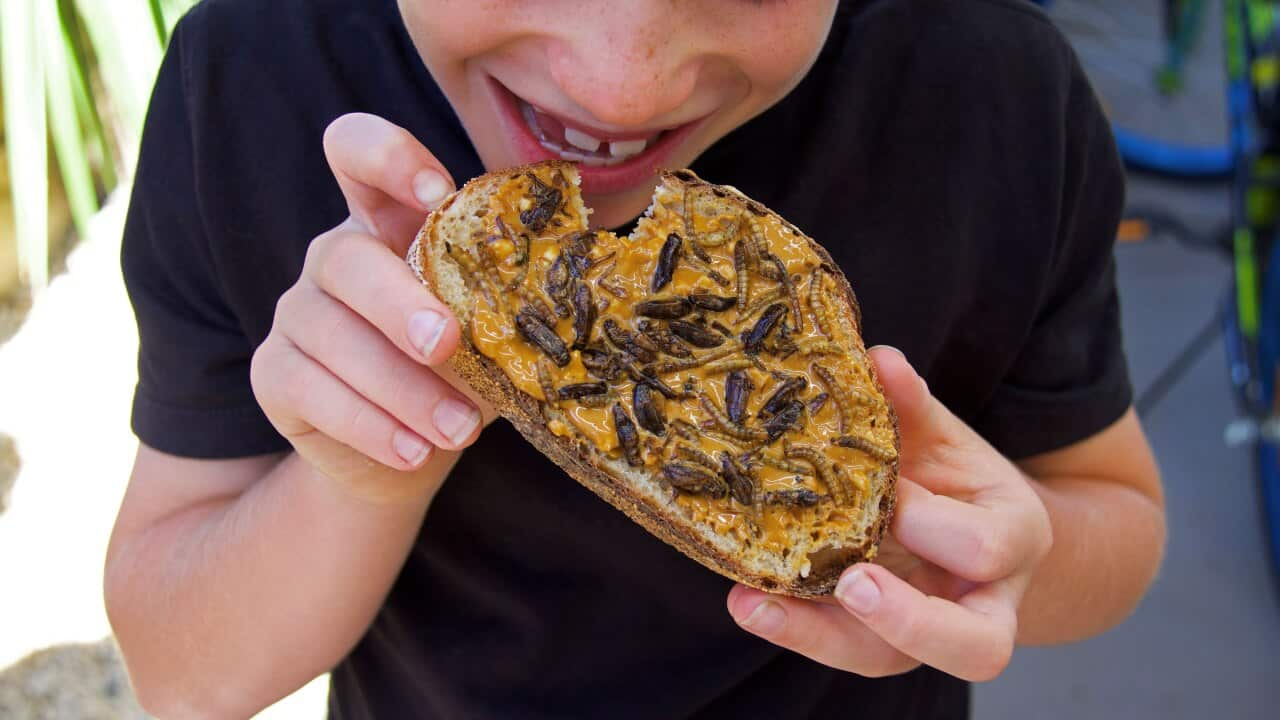Eating insects might not be mainstream here (yet), but it's not new. Indigenous people have been eating , and for thousands of years.
With this in mind, and because farming and eating insects is good for the environment, CSIRO scientist and her colleague have put together Australia's first edible insects .
Why eat insects?
"They're healthy," explains Dr Ponce-Reyes. "They have a high protein content and they have good fat. Crickets, for example, have more Omega-3 than salmon, and they have minerals like iron. Some insects have folic acid and different types of vitamins. Green tree ants are high in vitamin C, for example."
Also, farming insects in shipping containers close to cities means we don't need to clear habitat, which is one of the biggest threats to biodiversity. Further, insects can eat food scraps so we don't need to grow food for them, and their waste (which is minimal) can be used to fertilise gardens.
Oh, and they taste good too. Bogong moth is reminiscent of peanut butter, green tree ants have a citrus kick, and honey ants are known for their sweet, floral flavour.

Scientist Dr Rocio Ponce-Reyes and her colleague Dr Bryan Lessard have formed Australia's first edible insects roadmap. Source: Supplied
How and where to eat insects
One of the reasons that discourage people from eating insects is the so-called "". However, according to a recent , over 50 per cent of Australians said they'd likely eat insects going forward.
Although, even if people do want to eat them, they can be hard to find. In restaurants, they're most often served as a delicacy, like the black-ant lamington at Attica, or the Granny Smith sorbet and green-ant pre-dessert at Vue de monde – restaurants both located in Melbourne, Victoria.
More accessible is the of Seven Seasons, a distillery based in Adelaide, South Australia, which has received . It's green-ant gin is perfect in a negroni or a gin and tonic.
If you want to cook with edible insects at home, your best bet is to order them from an online shop like (also known as ). There, you can find products featuring cricket, ants and mealworms, ranging from flour and enriched pasta, to corn chips, snacks and candies.
Being from Mexico, Dr Ponce-Reyes is familiar with , grasshoppers often fried and seasoned with lime juice, salt and chilli. They're easily found at markets and eaten as a snack or included in recipes. Now living in Queensland, Dr Ponce-Reyes uses roasted Australian crickets in her cooking.
"I like to mix Mexican cuisine with Australian ingredients so I make quesadilla with cheese and roasted crickets inside. And the green salsa with tomatillos, it's the best with green tree ants, it's zesty and so good", she says.
The green salsa with tomatillos, it's the best with green tree ants, it's zesty and so good.
When she makes bread and cakes, she substitutes some of the flour for cricket powder, which provides more nutrition. She also uses cricket powder in smoothies.
" and mealworms are easy to use and you can eat them at different stages," she explains. "With crickets, if you eat them younger, they're less crunchy, they have more fat and less protein. When they get older, they're crunchier, have less fat and more protein."
Why Australia can become a leader in edible-insect production
Europe and the United States are in edible-insect production, but Australia is lagging behind. However, according to Dr Ponce-Reyes, we have everything it takes to become a leader in the edible-insect industry.
Thanks to Indigenous people, we have at least 60 native edible insects throughout the country, and there could be many more. Australia also has great agricultural and biodiversity research capacity.
"If you combine this great research capacity with the knowledge of Indigenous people and the diversity of species, this can lead to new opportunities to help the industry grow. And not only for humans, they're really good food in fish farms or for chicken or even for pets," she explains.
If you combine this great research capacity with the knowledge of Indigenous people and the diversity of species, this can lead to new opportunities to help the industry grow.
To get there, the scientist explains that Australia needs to invest in research and new technologies, which would help reduce the cost of producing insects.
Dr Ponce-Reyes highlights that we also need to increase the participation of Indigenous people in the edible insects industry. "Not just collaboration, we need to encourage Indigenous-led enterprises," she says.
"It's also very important to protect the Indigenous IP [intellectual property] when it comes to knowledge about edible insects in Australia. It would make the industry stronger."
Dr Rocio Ponce Reyes will take part in a panel about insects during this year's WOMADelaide festival in Adelaide. Find out more .



